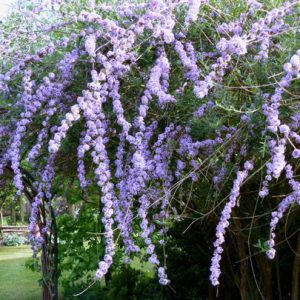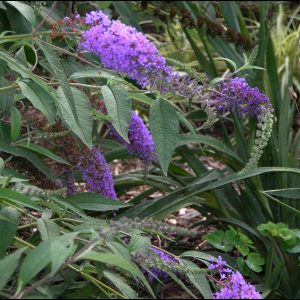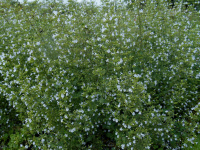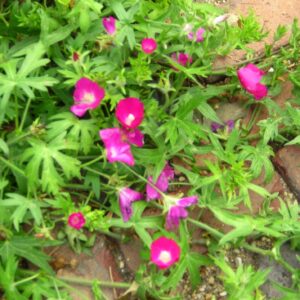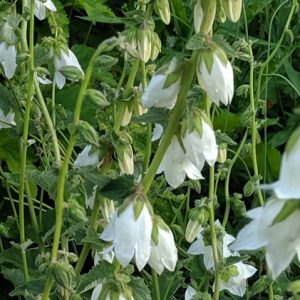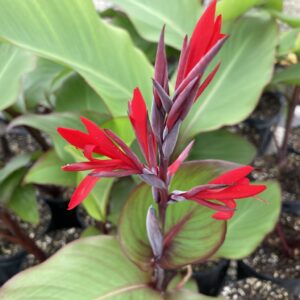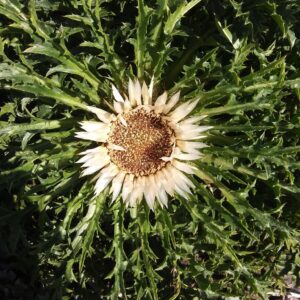Plants for Butterflies and Other Pollinators
Showing 41–48 of 223 results
-
Buddleja alternifolia ‘Argentea’ Silver fountain butterfly bush Z 5-9
Graceful, arching, weeping silvery foliage with cascading lavender flowers
Graceful, arching silvery foliage and, in early summer, lavender, fragrant flowers cascade all along the stems. A cloud of purple.
Size: 8-10” x 8-10” fast growing
Care: sun to part shade in moist well-drained to well-drained soil. Prune just after blooms finish if you wish.
Native: China & Japan
Wildlife Value: attracts butterflies
Awards: 1998 Plant Select ® awardBuddleja named to honor botanist Reverend Adam Buddle, Vicar of Farmbridge in Essex, (1662-1715) Alternifolia means the leaves alternate on the stem. The 1st Buddleja alternifolia was found by plant hunter and horticulture author Reginald Farrer (1880-1920) in western China in 1914. The cultivar’s name ‘Argentea’ means silver due to the tiny hairs on the foliage giving the plant a silvery appearance. ‘Argentea’ selected at Hillier Nursery in England in 1939.
-
Buddleja davidii Butterfly bush, Summer lilac, do ye zui cao in China Z 5-9
Fragrant, large, lilac to purple arching spikes from mid-summer through fall
Fragrant, large, lilac to purple arching spikes from mid-summer through fall
Can not ship to: Delaware, Maryland, North Carolina, Oregon, Pennsylvania, Tennessee and Washington
Size: 6' x 4'
Care: Sun in well-drained soil.
Native: Sichuan & Hubei provinces, China
Wildlife Value: flowers very fragrant, attracts many butterflies, excellent cut flower
Awards: Royal Horticultural Society Award of Garden Merit.Buddleja named to honor Reverend Adam Buddle, Vicar of Farmbridge in Essex and botanist. (1662-1715) Davidii honors Fr. Armand David a French missionary who noticed it. Introduced to gardens by another French missionary Jean Soulie (1858-1905). Soulie made dangerous expeditions to the Tibetan border of China and ultimately lost his life when he was tortured and shot in 1905. This species 1st sent to the West (Kew Gardens) by Dr. Ernest Henry who found it near Ichang in 1887. Irishman Dr. Henry worked as a customs officer in Shanghai and an assistant physician in Ichang.
-
Calamintha nepeta ssp. nepeta syn. Clinopodium nepeta ssp. nepeta Lesser calamint Z 4-9
Profuse violet blooms on mint-scented, gray-green foliage gives frosty image, June-October
Profuse violet blooms on mint-scented, gray-green foliage gives frosty image, June-October
Size: 18-24” x 8-12”
Native: Europe and Mediterranean
Wildlife Value: attracts bees, butterflies and hummingbirdsThis subspecies 1st described by Linnaeus in 1753. Genus name comes from Greek kalos meaning beautiful and minthe meaning mint. It is not, however, a mint and is not invasive.
-
Callirhoe involucrata Wine cups, Prairie poppy mallow
Magenta-purple upfacing cups, June - October
Magenta-purple upfacing cups, June – October, non-stop. Wonderful for rock gardens or as a ground cover.
Size: 6" x 12"
Care: Full sun in well-drained soil. Drought tolerant
Native: Missouri to TexasAlthough an American prairie native, Callirhoe is named for the daughter of the Greek river god. Teton Dakota burned its dried root for smoke to cure the common cold and aches and pains. First collected by Thomas Nuttall in 1834. Ferry’s 1876 catalog described it as having “a trailing habit, of great beauty.” William Robinson extolled Prairie mallow as “excellent for the rock garden, bearing a continuous crop of showy blossoms from early summer till late in autumn.”
-
Campanula alliariifolia syn. C. gundelia syn. C. kirpicznikovii Ivory Bells Z 3-7
July-August, creamy white bells dangle on spires above heart-leaved foliage. Vigorous. Cut back to promote 2nd flowering
July-August, creamy white bells dangle on spires above heart-leaved foliage. Vigorous. Cut back to promote 2nd flowering
Size: 18-24” x 18
Care: sun to part shade in moist well-drained soil
Native: the Caucasus and Turkey
Wildlife Value: attracts bees, butterflies and birdsCampanula is Latin meaning “little bell.” Described by Carl Ludwig von Willdenow in 1798
Highly touted by Graham Stuart Thomas, who once referred to it as a “picture of poise and beauty,” -
Campanula ochroleuca Bellflower Z 4-7
Ivory, rocket-shaped buds open to bell-like blossoms covered with fine hairs with five, flared petal-ends surrounding ivory stamens and pistil along erect to arching stems. Blooms June-July on slow-spreading, clump-forming rosettes of hairy, heart-shaped or triangular leaves.
OUT OF STOCK
Ivory, rocket-shaped buds open to bell-like blossoms covered with fine hairs with five, flared petal-ends surrounding ivory stamens and pistil along erect to arching stems. Blooms June-July on slow-spreading, clump-forming rosettes of hairy, heart-shaped or triangular leaves.
Size: 12-18” x 12-15”
Care: sun to part shade in moist well-drained to well-drained soil
Native: Caucasus
Wildlife Value: provides pollen to bees and butterflies, rabbit resistantFirst described in a published document in 1949.
-
Canna edulis Indian shot, Arrowroot Z 7-10, Tender Perennial
Several shoots of red, tube-like flowers atop a tall stalk , taller than its banana plant-like, broad, waxy, oval foliage, green with purple toward the top. Flower all summer.
Several shoots of red, tube-like flowers atop a tall stalk , taller than its banana plant-like, broad, waxy, oval foliage, green with purple toward the top. Flower all summer.
Size: 8’ x 3’ spreading
Care: sun in moist to moist well-drained
Native: Andes of South America, and the West Indies
Wildlife Value: attracts bees, hummingbirds and butterflies.
Size: Primarily grown as a root crop to eat, Roast or boil root like a potato. Root is source of arrowroot used as thickener.Edulis means edible.
Carbon dating of tubers shown grown more than 3500 years ago.In colder Zones, lift and overwinter indoors.
**LISTED AS OUT OF STOCK BECAUSE WE DO NOT SHIP THIS ITEM. IT IS AVAILABLE FOR PURCHASE AT OUR RETAIL LOCATION.
-
Carlina acaulis ssp. simplex Silver thistle, Weather thistle Z 3-9
Wide, white saucer flowers above silvery thistle foliage, open on dry days, closed in the evenings and on rainy days. July- September
Wide, white saucer flowers above silvery thistle foliage, open on dry days, closed in the evenings and on rainy days. July- September
Size: 6-12” x 12”
Care: sun in well-drained soil.
Native: Southern & Eastern Europe
Wildlife Value: attracts honey-beesThe Genus comes from Charles (Carolus). According to medieval folklore Charlemagne used this root to cure the ills of his troops.

